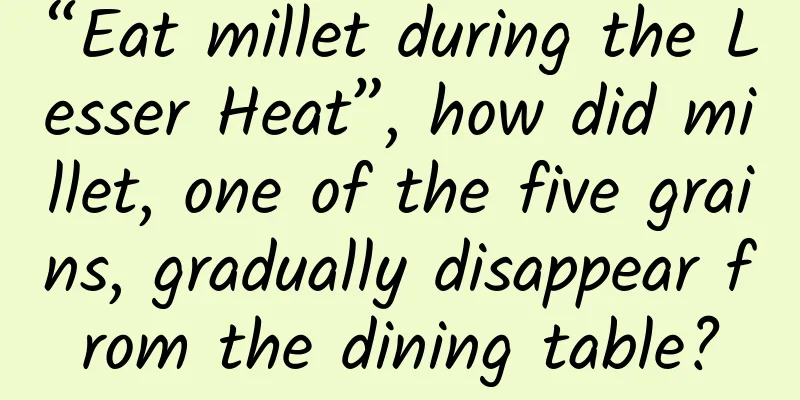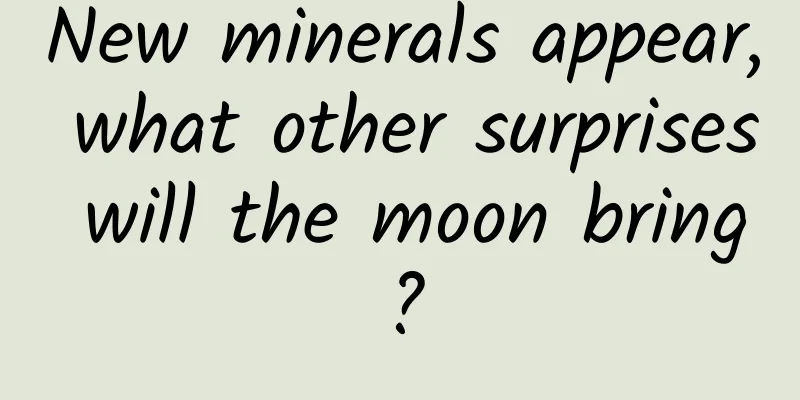“Eat millet during the Lesser Heat”, how did millet, one of the five grains, gradually disappear from the dining table?

|
"The sixth month of the lunar calendar... Heat is hot, and there are two types of heat: the beginning of the month is small, the middle of the month is large, and the heat is still small today." Although the name of the Lesser Heat contains "small", it should not be underestimated. "Lesser Heat and Greater Heat, steaming up and boiling down", the heat is rolling, no wonder Han Yu said: "Since May, I have been trapped in the heat and humidity, as if I were sitting in a deep steamer being steamed." In the Central Plains, people have a long-standing custom of eating new food during the Lesser Heat. During the Lesser Heat, people grind newly harvested millet into rice and cook the new rice into rice to offer to their ancestors. In ancient times, every household would eat new rice and taste new wine on this day. Millet is very unfamiliar on the dining table of modern people. Its colorful life sways in various ancient books and even poems. The ancients understood the wisdom of "eating millet in the Lesser Heat and eating grain in the Greater Heat". Before and after the Lesser Heat, peel the new millet and cook it into porridge, which is more palatable than pasta and rice. On this day in ancient times, every household would prepare a sacrifice after the meal to show gratitude to nature and ancestors, and then eat new rice and taste new wine. It is said that "eating new" means "eating spicy food", which is the first spicy day after the Lesser Heat Festival. Shuowen Jiezi says, "It is planted during the Great Heat, so it is called millet." Millet is a pictograph, with the lower part representing the root of the plant, the middle part representing the branches, and the upper fork representing the leaves of the plant. Millet is a dryland crop with slender and pointed leaves, like a thread, and needs water to irrigate. Millet has a very short growing period and can mature in 70 to 80 days. People in the north usually plant millet after the beginning of summer, when it rains heavily, and harvest it before the Mid-Autumn Festival. When I see the word "millet", I feel a sense of melancholy floating over me. My thoughts are repeatedly surrounded by verses of poetry, which make me think of ancient times and feel emotional. "In a good year, there is plenty of millet and rice, and there are also high granaries, tens of billions of millets and sorghum." During the Shang and Zhou dynasties, millet was the main dish on the table. In the Book of Songs, which was created in the Zhou Dynasty, there are only more than a hundred mentions of crops, but "millet" appears 21 times. "Big rats, big rats, don't eat my millet," is the lament of the people of Wei; "The millet is scattered, and the ears of millet are scattered." After King Ping of Zhou moved east, the Zhou officials passed by the ancient capital of the Western Zhou Dynasty and lamented the destruction of the palace and ancestral temples, which were overgrown with wheat and millet. They wrote the poem "The Separation of the Millet" to express their sad thoughts. "Those who know me say that I am worried; those who don't know me say what I want." It has become a permanent sadness and helplessness. So much so that in the Southern Song Dynasty, Jiang Kui still said in "Yangzhou Slow": "I am sad and feel the past and the present, so I composed this song myself. The old man Qianyan thought it was as sad as "The Separation of the Millet"." Archaeologists detected millet and sorghum crops at the bottom of the storage ruins at Shizhuang Ruins in Huaiyang, Henan Province. Xinhua News Agency (Photo provided by the Shizhuang Ruins Archaeological Team of Henan Provincial Institute of Cultural Relics and Archaeology) Among the five grains of traditional Chinese agriculture, millet has long been ranked first and was widely planted in the north in ancient times. At the Dadiwan site in Qin'an, Gansu, ancient ancestors had planted it 8,000 years ago. So far, this is the earliest crop found on the land of China. "There are more wine jars than infantry, and millet fields are wider than Pengze." "Irrigate the medicinal gardens in Yuling and cultivate the millet fields in Pengze"... After the Tang and Song Dynasties, wheat and rice gradually replaced the status of rice and millet, and the planting area was reduced. But in the Song Dynasty, Wang Anshi still said: "Wheat can be seen for thousands of miles without soil, and even the mountains are covered with clouds. Millet is planted." During the Ming and Qing Dynasties, the diet of ordinary people was already "half wheat." To this day, millet is only "a minor grain." In ancient times, people lined up 100 millet seeds and took their length as the standard of one foot, which was called millet ruler. It was the basic basis for the ancient measurement system. One hundred millet seeds weighed one zhu, and 24 zhu weighed one liang. Image source: Consumer Daily "Millet and sorghum are two kinds of the same kind. The sticky one is sorghum, and the non-sticky one is millet. Millet can be used to make rice, and sorghum can be used to make wine." The shelled millet can be used to cook porridge, make cakes, make rice, and make wine. In the era of the Book of Songs, "The good hoes and hoes are used to carry the crops to the southern fields. The crops are sown, and the crops are full. Someone comes to see the girl, carrying a basket and a basket, and she is eating millet." How happy would the farmer be to see the millet rice sent by his wife? This vivid plot adds a different interest to the harvested fields and makes the traditional rural life a poetic sublimation. "Don't refuse the wine, it tastes light, the millet field is uncultivated" and "My old friend prepared chicken and millet and invited me to his farm." How many people feel warmed by the scene of talking and laughing at the dinner table? Wine can add to the fun. No wonder "Quanxun" in "Lüshi Chunqiu" records: "Before the battle, Sima Zifan was thirsty and asked for a drink, and Shuyanggu served him millet wine." I have never seen millet, but from the descriptions of the ancients, it grows extremely luxuriantly in the summer, swaying in the wind, and should be similar to millet. The fruit of millet is light yellow. After peeling, it is called yellow rice, millet, summer millet, and yellow millet. It is slightly larger than millet. After being cooked, it is sticky, smooth and palatable, and has a strong toughness. It can be used to make a variety of sticky foods, such as cut cakes, yellow rice fried cakes, yellow rice, cold cakes, and yellow rice dumplings. Yellow rice fried cakes are a traditional Beijing snack with golden color, crispy skin, sticky and delicious texture, and sweet and smooth fillings. Yellow rice fried cakes made of millet flour are particularly resistant to hunger. The saying "30 miles of oat flour, 40 miles of cakes, 20 miles of buckwheat flour will break your waist" refers to it. Source: Popular Science Times Author: Ren Chongxi, Director of Henan Writers Association and Standing Committee Member of Kaifeng CPPCC Editor: Mao Mengnan Review: Wang Fei Final judge: Chen Lei |
<<: I will never forget this day!
>>: Alpine glacier collapse has killed 7 people! Is there any way to stop the melting of glaciers?
Recommend
Spring Festival promotion cannot be separated from these 7 major themes
The Spring Festival is one of the most important ...
Dismantling the entire process of Yuanqi Forest's layout of private domain
Purpose of case analysis: The number of followers...
Why do early products need seed users?
When it comes to the concept of seed users , I be...
Once the mortgage is paid off, the house is yours? Are you sure?
Addendum 1: It is recommended that you save this ...
How to write the Alipay interface for the Douyin mini program?
The process of connecting Douyin to Alipay First,...
Plug-in hybrid or extended range? Stop arguing! Volkswagen CEO has given the answer: plug-in hybrid models will be launched
Li Xiang, founder of Ideal Auto, recently pointed...
4 tips to teach you how to operate WeChat groups and QQ groups!
Few people know the purpose of group operations ,...
Fly high into the sky and see the green mountains and clear waters on earth!
On August 4, the world's first forest carbon ...
"Tasting the first" digital RMB security and convenience are the primary prerequisites
[[407805]] Our reporter Sun Zhao After learning t...
Longer term trends of the top 10 programming languages ranking (1989-2014)
IOBE has just released the November programming l...
What killer applications have emerged in the mobile Internet in the past decade?
If Apple and Google hadn't added an app store...
This most common cooking oil promotes cancer cell metastasis and increases the risk of spread
When you eat biscuits, instant noodles, or fried ...
Taking a book sales website as an example, let’s talk about how to increase the paid conversion rate
Paid conversion means: getting users to consume a...
What is legitimate defense? How can we act bravely?
Mixed Knowledge Specially designed to cure confus...
Insomnia, irritability, frequent headaches...People with these symptoms should pay attention!
Expert of this article: Wang Li, attending physic...









